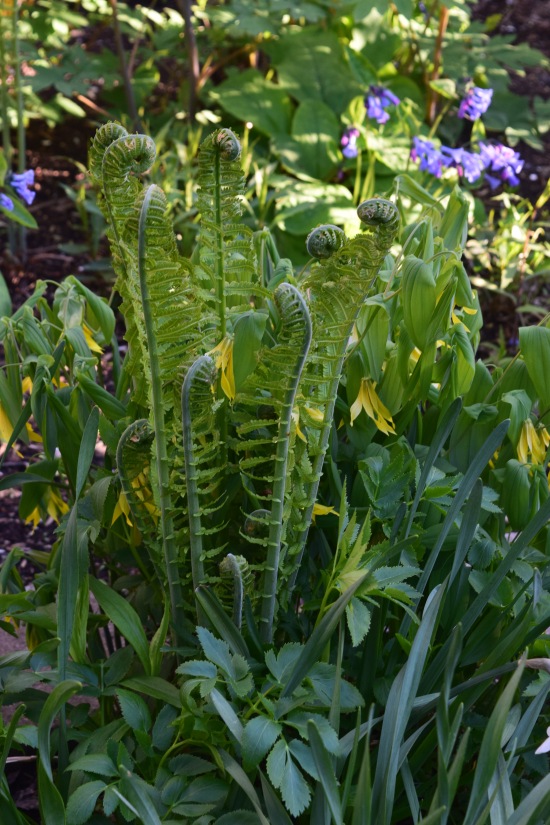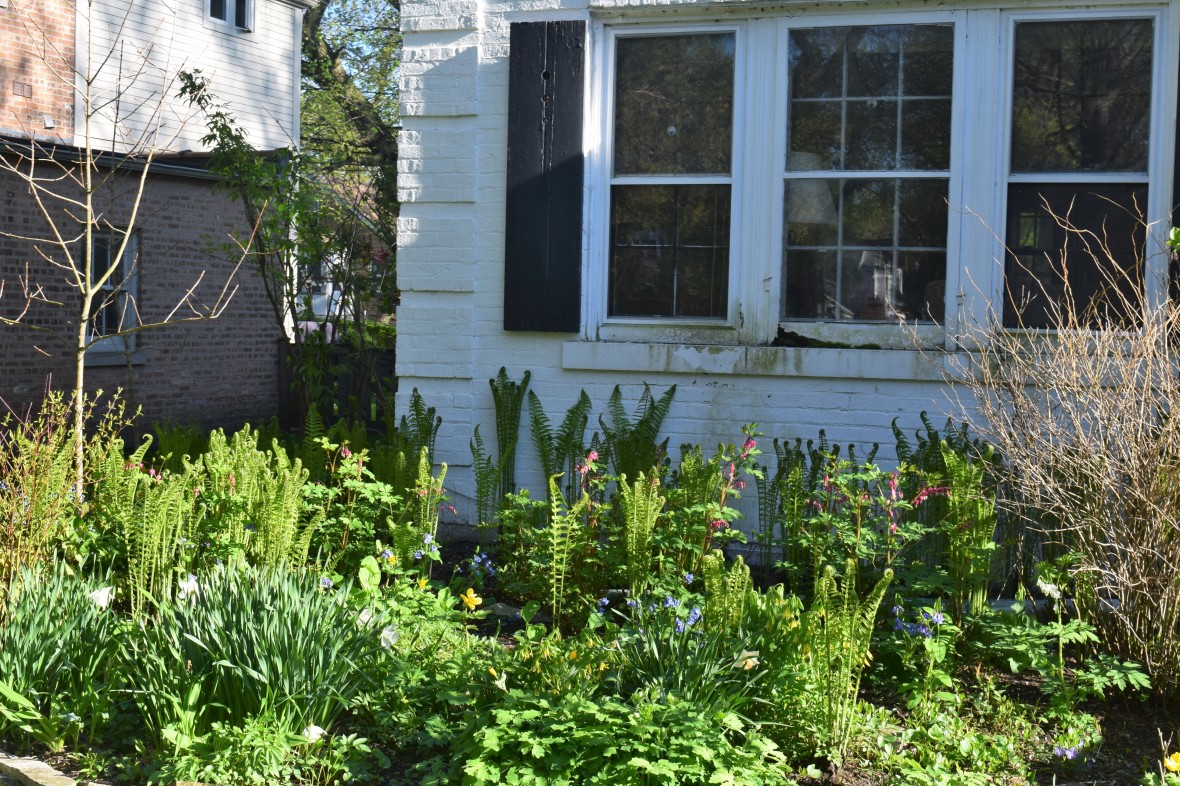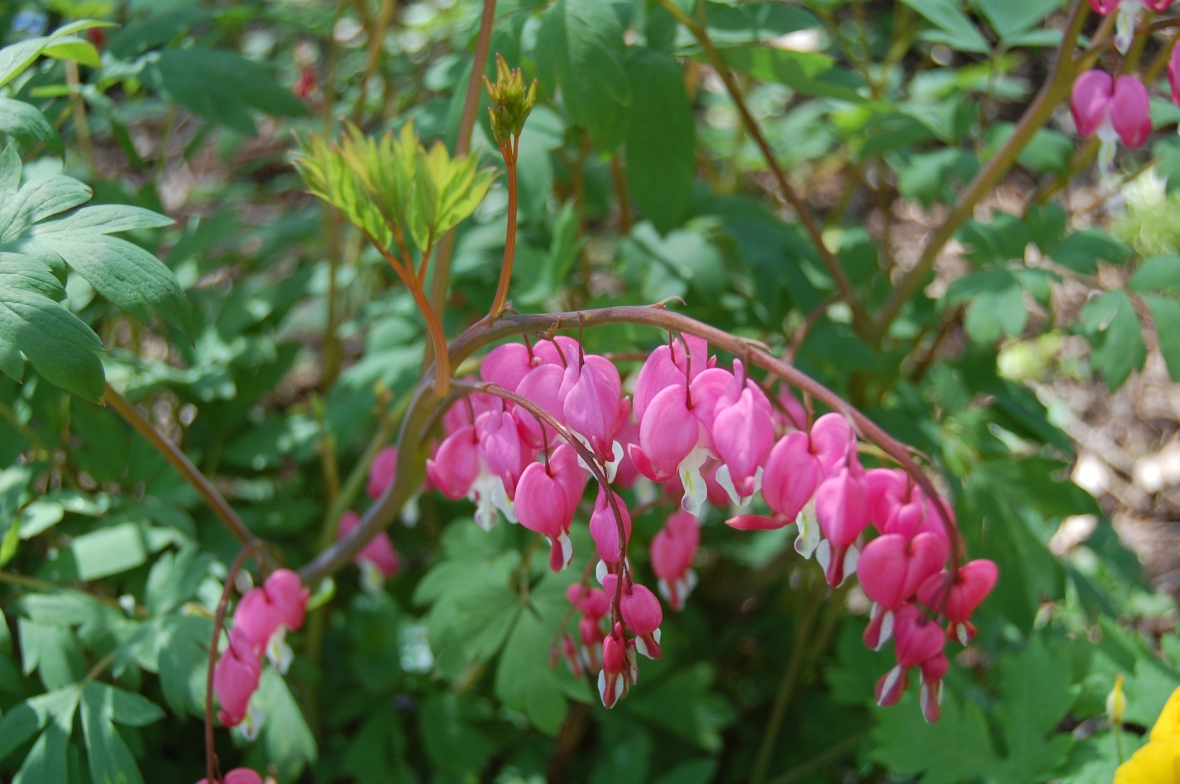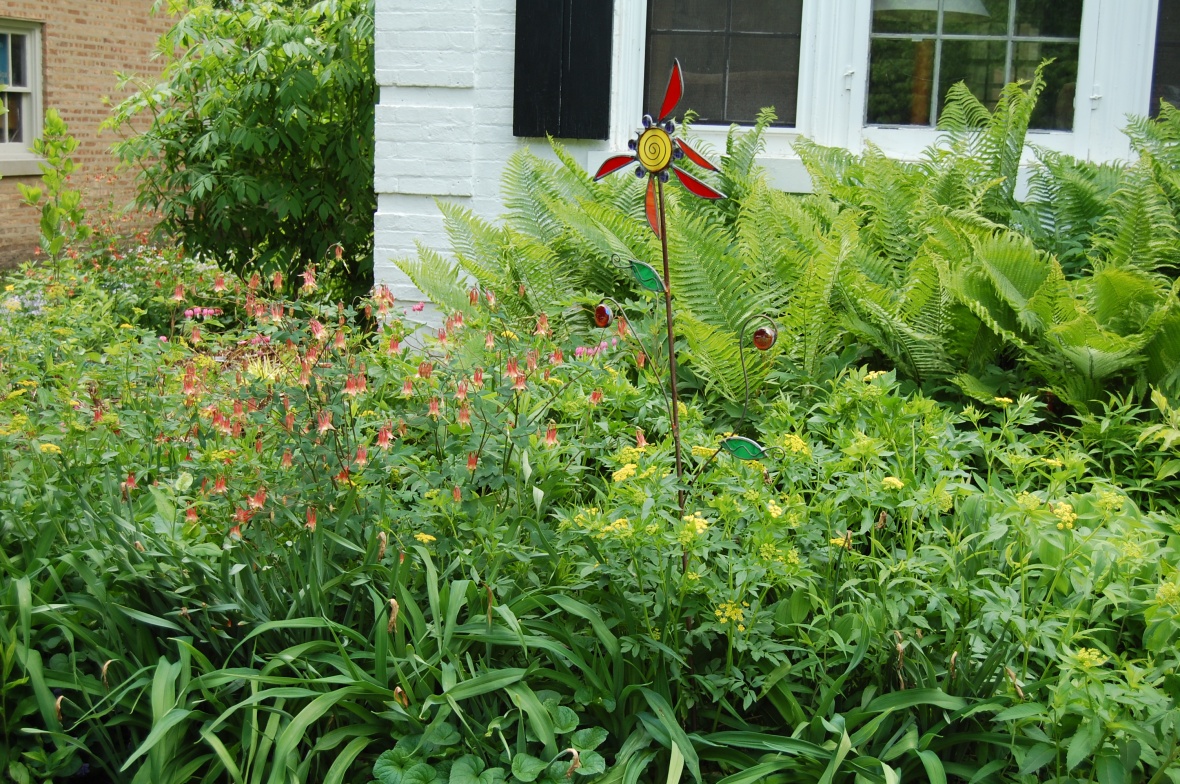A Fern Foundation
Somewhere it is written that foundation plantings must be evergreen shrubs (Yews, Boxwood, and the like). and that these shrubs must be clipped into geometric shapes. Judy and I, however, have defied this commandment and have come up with a different sort of foundation planting: Ostrich Ferns (Matteuccia struthiopteris) and allied perennials. I would also consider grasses, but the front of our house faces north and is in quite a lot of shade.

Right now the Ostrich Ferns have reached what I like to think of as their annual young adulthood. Like many other plants, they are at least a couple of weeks behind schedule. They are no longer cute little fiddleheads, but not yet the towering fronds of summer. At their tips they are still unfurling (unfurling fronds always look optimistic and vibrant to my eyes), and they wear a fresh, light green.

Ostrich Ferns have one major defect as a foundation planting: in Chicago, at least, they only last a little more than half the year. The rest of the time the area where the front of the house meets the ground is exposed. For many people this is akin to walking around in public without your pants, but I don’t feel that way.
For one thing, starting in mid-summer the view is obscured by the tallest plants in the Front Island Bed, at least until they are cleared out in April. Plus, for much of that time it’s too cold for people to be staring at the ground along the front of our house. People are just trying to get where they are going as quickly as possible.

There are a number of native plants that make excellent companions for Ostrich Ferns: Virginia Bluebells (Mertensia virginica), Great Merrybells (Uvularia grandiflora), Golden Alexander (Zizia aurea), and Wild Columbine (Aquilegia canadensis).

All of the above are Midwestern natives, but I couldn’t help including one exotic plant: the Old Fashioned Bleeding Heart (Lamprocapnos spectabilis).

I find Bleeding Hearts to be irresistible.

Here’s how the Ostrich Ferns look at their summer peak. This was taken a few years ago.
The other problem with Ostrich Ferns is that they spread, and you have to dig them out if you don’t want an Ostrich Fern plantation. However, I’m trying to figure out how tightly I have to enforce an Ostrich Fern cordon sanitaire. To what extent can they coexist with other perennials, or will they smother everything wherever they stake a claim?

Here’s another view of the Ostrich Fern foundation planting, taken a few years ago, with Wild Columbine and Golden Alexander in the foreground.
Have you ever tried using ferns or grasses as a foundation planting for your house?





Just last summer I took everything out of the foundation planting in front of my house and redid it with grasses and prairie/meadow-ish perennials. So far this spring I like the look, although with it being new it’s still a bit sparse. I’m hoping it won’t be too long before it fills in. There is a single shrub in there, an Arctostaphylos (aka manzanita), which likes summer drought. I have a single ostrich fern here in my garden, planted directly into the running water of the stream. They like wet feet, and that’s the only spot where it would stay wet enough all summer here.
I think grasses are a good idea. I might even mix some grasses along with the Ostrich Ferns in front of the house so it’s more substantial over winter.
I have those ferns too in my garden. I know they selfseed a lot but when the plants are still small you can remove them quite easily. Maybe you can plant shrubs between the ferns or behind them who become taller than the ferns and when you remove the lowest branches you get a shrub on a trunk , like a small tree.
Interesting idea, thanks. I should dig out the extra ferns more regularly but I always wait until after some of them are quite substantial.
There is alway so much work in the garden, isn’t it !
That’s for sure!
Ferns are too difficult for us to grow in Canberra, but I do LOVE your Ostrich Ferns photo, it gives that lovely green cooling effect. I also love the Bleeding Heart, which we did grow when living in Sydney, it was always a lovely surprise when it flowered.
I guess there are few ferns happy in an arid climate. I imagine there are plenty of ferns in northern Australia, though.
There are some wonderful ferns in Northern Australia, I must take some photos of them when next we go there.
I love your fern planting. It is gorgeous and so lush.
In our small garden I have done a somewhat similar
thing along the entrance stairs. Our planting has hostas, wild ginger, Jeffersonia diphylla, bloodroot,and Solomon’s seal. I too have a bleeding heart tucked in there and hope to get some Mertensia at our Audubon native plant sale soon. We also have a young shadbush in there which I’m hoping will bloom this year.
The only drawback to the Ostrich ferns is that in late summer they start browning. This happened in our Michigan garden as well. I’m curious as to whether yours do the same thing?
Depends on how hot and dry things are, but yes, generally in August or September they start to get a little ratty.
I like your planting by your house. I have my ostrich ferns in my bog garden as they like moisture, but they do run and I have to be quite firm with them, pulling them up if they are getting too boistrous with other plants.
Spare the spade, have a garden full of ostrich ferns.
We had a major run of Ostrich Ferns along the north side of our house. I cleared them out many years ago and planted other plants in their place. They still pop up here and there. I leave them until they get too thick or intrude on another plant. As Ann mentioned in her comment they get pretty ratty looking at the height of summer when it get droughty here. One reason I don’t encourage them too much.
That can be a disadvantage. But they are so wonderful in spring and most of summer.
Oh my gosh ! I can’t believe how “alike” we are with the ostrich fern .. obsession? LOL
I have them dotted all over the place and yes there is always that “tug” with how far do I let them take over and do they hinder other plants .. but oh ! they provide such lushness and greenery, I have to consider them a bit of a backbone plant to my gardens .. they fill in the gaps and highlight other plants in their own way.
I love this post ! .. it is great to find another fernatic ! haha
P.S. … I have lots of other fern cultivars .. Japanese Painted .. woodland types … they are all gorgeous to me .. I think because I loved ferns as a child when i walked in the forest ..
I was besotted with them ! LOL
I have some Lady Ferns, the straight species, and another tall one (not as tall as the Ostrich Fern) of unknown species. I would really like to plant some Maidenhairs.
Ostrich fern fiddleheads, unlike those of most other ferns, are edible. Since that’s a moment when they’re visible and easily removed, a spring feast might help with their relentless spread.
Are Christmas ferns (Polystichum acrostichoides) hardy in your zone? They’re evergreen, so provide cover for birds and visual appeal for humans in the period when ostrich ferns aren’t up. They’re a darker green, and not as tall as ostrich ferns, so might be nice accents for your shady patch. They don’t spread anywhere near as vigorously as ostrich ferns, either.
That’s a great idea, though I’ve eaten fiddleheads and thought they were just meh. Still, much better than trying to dig them out, they can be stubborn SOBs.
Beautiful! In our backyard by the foundation, it is all ferns. I did not have to do anything except stop mowing right up to the house. The ferns seeded themselves. I love the way they look, and I especially appreciated not having to buy anything.
I imagine the Maine woods are full of beautiful ferns.
Yes, the Maine woods all around our yard. Since living here, I have come to love ferns.
I love the look of those ferns but hate that aggressive tendency. I grow Dryopteris felix-mas ‘Linearis Polydactula’ and Dryopteris crassirhizoma (killer names) which get tall and last until the snow buries them. They come up a bit later than Ostrich ferns but don’t have any of the downsides.
I have Dryopteris filix-femina. I used to think it was D. felix-femina, so I thought it was Latin for Cat Lady Fern (for some reason I thought Felix was Latin for cat). Anyway, it’s a nice fern, now I’m curious about these other species from the genus.
I don’t have ostrich ferns, but I have and love Christmas ferns, which don’t spread in my yard, and Briallance Autumn ferns that don’t really spread, but they are noticeable larger every year. These two ferns are both evergreen in Central Virginia, but they begin to flop in cold weather. I also have Japanese Painted ferns, and they may be my favorite. They disappear completely in my area, which I don’t like, but they spread, which I do like. I’ve acquired many free plants by dividing them when they get too wide for the spot they’re in. Enjoy your Ostrich ferns.
I might want to try the Christmas ferns, I wonder if they would be evergreen in our area.
I love this look, so much better than boring clipped shrubs. I have a nice carpet of Adiantum venustum, aka Himalayan maidenhair fern, growing on the north side of our house. I’d plant Matteuccia struthiopteris there in a heartbeat if they could withstand the hot dry summer.
Himalayan maidenhair sounds interesting, I wonder if they are very similar to the North American maidenhair.
I just may have to add some ostrich ferns under my bag window, yours set a splendid example! My front “foundation plantings” include: a dwarf rhodie, a sm. azalea, 2 abelias, a big hydrangea, major wheeler lonicera, an old deutzia, a blueberry viburnum, and a crape myrtle in front of side porch. Not a classic array, in fact they’re all relatively bare in winter. My cottage is wide; the kitchen, dining room, living room, and side porch all face the street. Yay for gardening outside the box! Love your blog, Jason, and your gardens!
*bay window (darned auto-correct)
That sounds like a planting with year-round interest, as they say, by your house. I like to mix it up in shrub plantings.
I love your ferns! I have a lot of grasses but have never tried ferns. Although it’s occurred to me, I don’t know if I have any place to do them justice except perhaps under a tree or two…while that seems to work in nature, complicated for me.
They are a good filler in a shade garden, some of them need a lot of moisture. Grasses are good, I’d like to have more.
Absolutely beautiful! I’m fascinated by ferns — they remind me so much of something from the earliest days of plant life on earth, and their structure is mesmerizing. Well done.
Yes, they do have sort of a prehistoric vibe.
Thanks for the warning that ostrich fern can spread. I’ve contemplated replacing some of my hostas with ostrich fern on the north side of the house. That bed is fairly self-contained, so maybe I can still try them. I have tried switch grass, northern sea oats, and pampas grass on the east side, but they get less and less sun each year and consequently have been rather floppy, so am planning to move them to the south side (which has a rather large overhang, so they won’t get baked). Also, the sea oats seed other beds, another reason to exile them elsewhere.
Switchgrass really wants a sunny spot, but Sea Oats should be able to tolerate some shade. They do seed around, though.
We actually have a few holly ferns mixed in with the oakleaf hydrangeas we have as out foundation planting. Yours look amazing all curled up. I like them all grown up in the summer pictures too, but there is something about those curls.
I agree about the curls. Are the holly ferns evergreen?
There are no shrubs anywhere near my foundations except a lilac on one corner.
I’d rather see ferns and flowers than yews and junipers.
Totally agree!
I can’t remember seeing ferns used in this way in my area, although they surely must be around, given the number of online articles I found extolling the virtues of ferns for Houston and east Texas. We did have them on the west and north sides of the house when I was growing up in Iowa, and I remember my mother finally giving in to evergreen bushes in the front of our new house after her beloved ferns just couldn’t cope with a southern exposure. Ferns beat those evergreens every time in my book — especially the severely clipped geometric shapes.
Too bad your mother’s ferns weren’t on the north or east side of the house.
Your house, your landscape. 🙂 I love ferns, love them. But, I don’t particularly like how some spread and require digging each year to keep them gone. I have several but not the spreading kind. Love your Bleeding Heart. 🙂
All of mine spread to one degree or another, though Ostrich ferns are the most imposing and the most aggressive.
It looks perfect to me!
Thanks!
I do like the fern hedging and the companion plants. The ferns in my garden are indestructible. I too love bleeding hearts, they have such a long season.xxx
I love your ferns. Thanks for sharing the inspiration.
You’re welcome!
I love ostrich ferns. As for foundations to my house, I favour concrete 😉
A solid choice.
I love ferns too and the ostrich fern is lovely, I can’t find a damp enough spot to keep it happy. I love the aquilegia.
There are some ferns that don’t need so much moisture, though I couldn’t tell you the species off the top of my head.
I missed that memo. Foundations plantings are nice, but so many of the homes on steep hillsides lack them altogether. For many, ferns just make sense. It can be dark down there.
I guess it’s more of an eastern thing. Around here there are no steep hillsides, so that’s not an issue.
Foundations plantings might have become more standard there because of the older architectural styles. Most buildings in California were built with gutters on the eaves. There is no need for vegetation below the eaves to prevent water and mud from splashing back up against the bases of the walls. Even though most buildings in the East are likely outfitted with gutters now, the landscape styles were likely influenced by landscape features that were practical centuries ago, such as foundations plantings. I remember that when I designed my home with Early American architecture, diversion of water from over the doorway, even without a porch, was a concern, and that ‘something’ needed to be planted below the eaves for water to fall onto.
Hello Jason, I’m always taken by your ostrich fern. I occasionally try and keep a look out for them at the garden centre as I wouldn’t mind having them in my garden too. We have had lots of success with “normal” dryopteris ferns and we’ve been able to propagate them from spores, which is just as well given how expensive ferns are in general to buy. I’ve only just discovered that they are actually self-sporing in the garden – do you find your ostrich ferns doing that too?
I haven’t noticed them spreading by spores, which doesn’t mean they don’t. But they definitely spread by rhizome.
They look lovely, but the spreading aspect always worries me. I want to include some ferns in our north facing areas, but want to keep it to those that are not that aggressive when it comes to spreading.
There are some that are less aggressive than the Ostrich ferns. I just need to do an annual Fern Digging Day.
I love these ferns, Jason – I have a swath of them at the edge of the woods, where they are swamping a tall birdbath (!) and have placed a few in the front of our house entrance on the north side. They work great here because the snow piles up in the winter and they remain dormant but then spring up for a tall green shrub effect on either side of the porch; the hellebores here hold their own against the ferns and the contrast in foliage is fun. Also, the deer don’t eat them – win, win.
Good to know that the Hellebores can hold their own. We don’t have deer, but they are also resistant to the voracious rabbits.
Hi Jason! I’m so happy to find this post while googling “ostrich fern companion plants”! I have been pondering what to plant right in front of our house after we finally bit the bullet and painted a 70s-style brick (coated to look like it had black and white powder on it or something) a beautiful light yellow. To make room for the painters, we did something else we had also wanted to do for years — which was cut down the two yews on the corners, one of which is a great snag now and the other of which is just severely back for now while it serves as a kind of protector for the new and tasty plants I’m getting going around it, like beautyberry. There was also one of those short Japanese maples that was just not helping animals much, so we turned it into a sculpture and are going to plant new things there.
In that spot we have a whole empty strip along the sidewalk now, and today I’ve been pondering moving some ferns there — it’s wet and a bit shady, and they would look so pretty against the yellow. I’m trying to think of some shrubs to intermingle because the windows are rather high up (It’s a split level, so part of the wall is actually the garage). I have elderberry sprouting in a place where it’s likely too dry for elderberry, so I wondered moving it to this spot … Or maybe winterberry, but it’s probably too shady in this spot. Do you have any ideas?
I like your idea of putting bluebells, columbine, and golden alexander there with the ferns — all of which I could move from other places. It’s possible that I don’t really need shrubs there after all. It’s interesting that we have similar situations — this is a spot that is obscured from view by chokeberries that are just across the pathway, on the other side of the sidewalk. But it would be a nice surprise to come around the bend and see the ferns, and and it would also be a very nice hiding/foraging place for all the animals who love the chokeberries and golden ragwort just across the way. Anyway, thank you! Your beautiful photos help solidify my plan! 🙂
You’re welcome! A couple of other shade-tolerant shrubby options you could consider would be one of the dwarf Summersweet varieties or Shrubby St. Johnswort (H. prolificum).
Hi Jason! I just saw this for some reason. Thank you so much. We have shrubby St. Johns wort popping everywhere now – which I love. Finally my clethra is spreading in back (after many years), so maybe I can dig up some pieces of that and move them to the front – good idea. 🙂 Right now Virginia creeper has decided to start to fill in, which is nice on the ground layer.